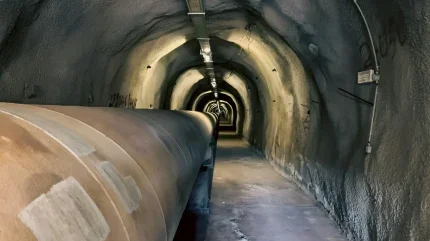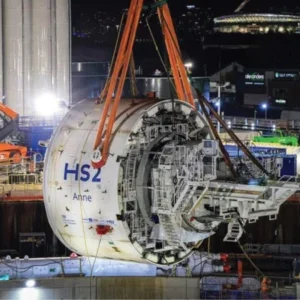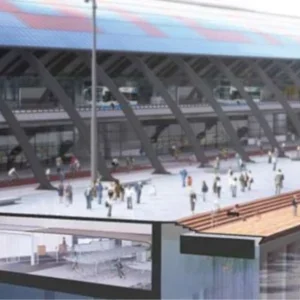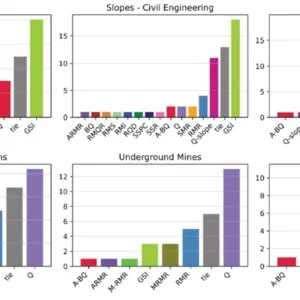
Construction of Abu Dhabi’s new 40km gravity sewer has reached another major milestone with the award on 30 November of a USD 200M contract for the second of three contracts for the bore. The 10km section will have a 7m external diameter with a 5.5m internal diameter.
Italian firm Impregilo beat bidders such as fellow Italian firm Astaldi, Germany’s Ed Zeublin, UAE based Lindenberg and French firm Bouygues Batiment International. “In addition to the tunnel, the project involves construction of four access shafts to depths of between 60 and 80 metres, as well as the links to the main tunnel,” says the Impregilo statement on the contract which is expected to take three years to build. Rates of up to 100m per week are expected. “The project presents significant technical and organisational complexities. It involves simultaneous use of two earth pressure balance tunnel boring machines for pressures up to 8 bars, to bore and simultaneously line the tunnel with prefabricated concrete elements,” says the statement.
The contract is the second awarded to Impregilo, which this month is starting boring a 15km central section of the sewer worth AED 891M (USD 243M). The award was made in September 2009 and involves three 6.3m diameter EPBMs. A further three contracts are also still to be awarded for connecting tunnels and a major pumping station.
A third tunnelling contract for the remaining 17km of tunnel, with a 4m internal diameter, is still to be awarded. Korean firm Samsung is understood to be among the bidders. Contract awards have been slower than anticipated as Abu Dhabi’s Executive Council has thoroughly reviewed the need for all major projects following the global economic downturn, and the financial pressures placed on the United Arab Emirates, which has had to give more than USD 10bn in support to the emirate of Dubai which has struggled to meet its financial obligations to lenders – mainly in the real estate sector.
Coping with growth
However the need for a new sewage system was never in doubt. When the government of Abu Dhabi first installed a sewage collection system back in the 1970s it could not have predicted the stratospheric growth that was to characterise the next four decades. From a population of around 156,000 in 1975, it is today approaching 1 million and the network of 50 pumping stations and mains that collect sewage and transport it to Mafraq treatment works is under severe strain. The result has been some surcharging of the gravity mains that feed the pumping stations and not surprisingly this had led to complaints from the public.
Solving this issue will involve the construction of a new 40km sewer with 50km of connecting sewers and a new pumping station at Mafraq. Starting on Abu Dhabi Island at 30m below ground level, the tunnel will run southwest to the mainland and terminate at a depth of 100m. Each bore will be 5km in length meaning that a total of eight EPBMs will be required. “We knew that breaking it into eight contracts would be too small for international contractors, so we broke it into three contracts, roughly around AED 750M (USD 204.2M) to AED 1bn (USD 272.3M) each. These were large enough to attract international tunnelling contractors but not too large that you put all your eggs in one basket, ”says Robert Marshall, Strategic Tunnel Enhancement Project (STEP) programme manager from CH2MHill, who was interviewed by T&TI in August.
The organisation charged with managing and upgrading the sewer network is the Abu Dhabi Sewerage Services Company (ADSSC), formed in 2005 and until 2009, a subsidiary of the Abu DhabiWater and Environment Electricity Authority (ADWEA). and bBack in 2006 it undertook a masterplan which explored the potential issues that the emirate would face, along with proposing solutions for the network. “The original masterplan consultant GTZ Dornier called it a sewage time bomb,” explains ADSSC managing director Alan Thomson. “It predicted that by 2009 Abu Dhabi would face mass sewer flooding. I am delighted to say we have managed to prevent this so far and we will continue to do so until the final solution is in place,” he says.
ADSSC’s masterplan envisaged that to meet projected growth of up to 3.1 million by 2030 the best solution would be a deep sewer tunnel that would collect effluent and transfer it all to a single pumping station by gravitation. This would then move flows to a new sewage treatment works at Al Wathba. As implementing something on this scale was beyond the experience of ADSSC, it decided to bring in a project management consultant to run the scheme. The winning bidder was announced as US based CH2MHill in February 2008. The firm was fresh from project managing Singapore’s impressive 48km deep sewerage tunnel (DTS) project. “We looked at the tunnel route, what length it should be, where it should go, what diameter it should be, what gradient and what depth,” says Marshall.
As with many tunnelling schemes the client opted for a design and build approach and estimate that this saved 12 months on the construction programme as it allowed TBM orders to be placed at contract award, enabling detailed design and shaft sinking to be done in parallel with procurement of the boring machines. Designs were produced to approximately 30 per cent complete for the tender documents to be issued and to date all six contracts have been tendered and bid.
The EPBMs are new machines coming from Herrenknecht’s main facility at Schwanau in Germany. The first was installed in the launch shaft in mid-October last year with boring getting underway in December. The other two TBMs are on a one month lag. Construction of this section is set for completion by June 2013.
Originally it was envisaged that the entire STEP programme would be completed by the end of 2012, however the Abu Dhabi government is carefully reviewing all of its growth forecasts in the light of the global financial crisis. The emirate has a reputation for conservative planning, a move that has served it well as neighbouring states have seen their growth plans plummet – along with bank lending.
As a result although the remaining four contracts have been evaluated by ADSSC and a preferred bidder has been chosen, they are still awaiting approval from various government departments.
Given the current situation Thomson expects that 2014 is now a more realistic deadline for the project. “The other elements will be approved in due course. It is really just going through the bureaucratic procedures which are part and parcel of government controls,” says Thomson.
The remaining tunnelling contract to be awarded is a 17km length from Abu Dhabi Island to Mussafah on the mainland and will have a 4m internal diameter.
Cutting the sewer
The presence of gypsum presents a potential risk for the tunnellers. Its propensity to dissolve in the presence of groundwater has led to a series of underground voids and caverns on the mainland, which the team refers to as “solution features”.
This risk led the contract team to specify pressurised face tunnelling for the bore to prevent any uncontrolled ground loss, and although ADSSC did not specify whether EPBMs or slurry, all contractors bid using EPBMs. “We also require the EPBMs to have the ability to forward probe and we have asked the contractors to provide forward looking radars to pick up any cavities. And we have compressed air so we can get into the cutterhead if there is a need to change tools,” says Marshall.
Extensive site investigations have also been carried out with more investigation to be done prior to boring. “If a cavern was detected we would try and grout it up either from the tunnel or from the surface in advance of the TBM arriving. So far there is no real evidence of any solution features in the depths we are tunneling in,” says Marshall.
From a tunnelling perspective ADSSC and CH2MHill are optimistic about the ground conditions as despite large pressures at the deepest point of the tunnel – 8 bars, permeability of the ground is very low. “The biggest risk is encountering a very large cavern. The probability of this is low but the impact is high,” says Marshall.
The EPBMs will place a 200mm thick concrete structural lining and once this is complete contractors will enter the tunnel with steel shuttering to place the internal lining that also acts as a dual corrosion protection system. This comprises HDPE that is in contact with the flows and a concrete backing cast in situ that is at least 200mm thick. “The structural lining is gasketed so it should be a dry tunnel. Any leakage that comes in from groundwater would find its way through the concrete and run down the back of the HDPE and run onto the tunnel invert as the bottom 30 degrees is not lined in HDPE, “explains Marshall. “If it was fully lined then any water coming in would not be able to penetrate and so would bubble it until it burst, but ingress is expected to be very minimal,” he says.
The HDPE itself will be supplied in 2.5m roles which will be welded together on the surface before running it into the tunnel and wrapping it around the steel shutters. The concrete liner will then be poured. This is a similar method to that used on Singapore’s DTS. “In Singapore for example we had some shutters that were 37m long,” says Marshall.
Linking in
Beyond the tunnel itself contracts are also to be awarded for two link sewer packages that will feed flows in to the new sewer tunnel. Part of the rationale behind structuring the main tunnel and connection sewers in separate contracts is to enable both local and international firms to participate in the scheme and it is envisaged that local firms will be involved in link sewer construction.
Between the the two link sewer contracts a network of 50km of connection pipes will be created. Marshall says these are not expected to be at risk of encountering solution features as the majority of them are on the island where such caverns have not been a problem.
Connection sewers range from 400mm to 3m diameter lying anywhere between 10m and 25m deep. These will be pipejacked in place from manholes at 3m centres and the biggest challenge for the team will be getting authority approvals for the detailed designs of the jacking pit locations and receiving pit locations.
The sixth contract to be awarded is for the new deep pumping station at Al Wathba sewage treatment works. “A single pumping station design was a major consideration in cutting down odour problems in the future as wherever you have a pumping station you effectively have sewage coming to the surface in one way or another and more likelihood of an odour problem,” says Thomson.
ADSSC has reserved a 4.7 hectare plot of land from the Abu Dhabi Municipality for the pumping station and ground conditions are expected to consist of overburden soils followed by a weak sedimentary rock formation. Contractors will be expected to take into account expected artesian ground water conditions. According to ADSSC the construction of the pit could involve reinforced concrete diaphragm walls, secant pile wall, shotcrete and rock bolts, followed by inner structural concrete ring walls, intermediate slabs, and a base slab. However the most appropriate form of excavation support system will be left up to the contractor.
Although the government is taking its time over awarding the contracts, the consensus seems to be that this piece of infrastructure is badly needed, and it is part of wider investment in the emirate’s water network. “We are building another four waste water treatment plants, two in Abu Dhabi itself and two to cover Al Ain the second city. These are well in advance and will add an extra 800,000m3 per day to our treatment capabilities across the emirate,” says Thomson.
The current capacity at Mafraq is 360,000m3 per day but Abu Dhabi is currently averaging 500,000m3 per day. Fortunately for ADSSC the heat accelerates the bacterial activity that kills pathogens so although the wastewater is not being treated for as long as it was designed to be, the effluent leaving Mafraq is still high enough quality to be used for irrigation. As an interim arrangement ADSSC has placed connection pipes between the existing Mafraq sewage treatment works and the new treatment plants which will convey some waste water down to the new plants to relieve Mafraq. “Flows have increased 8 per cent, per year. We are making temporary arrangements with overland pumping, tankering where that is practical, and a refurbishment of some of our pumping stations if only for a few years to improve efficiency to keep the wolves from the door,” says Thomson.
Much work remains to be done before Abu Dhabi’s sewage problems are a thing of the past but major steps have been taken and a solution is on its way. The government is taking its time making the awards but at the same time is ensuring that Abu Dhabi gets the best infrastructure available. As a result the experience gained herein terms of both expertise and knowledge about local ground conditions, will be important information for other local and regional projects in the future.
The 40km tunnel system was divided into three contracts A 50km network of sewers will feed the main sewer tunnel A typical section through the deep sewer tunnel Abu Dhabi’s deep sewer is needed to support population growth Robert Marshall of CH2MHill Preparatory works underway at the launch shaft






